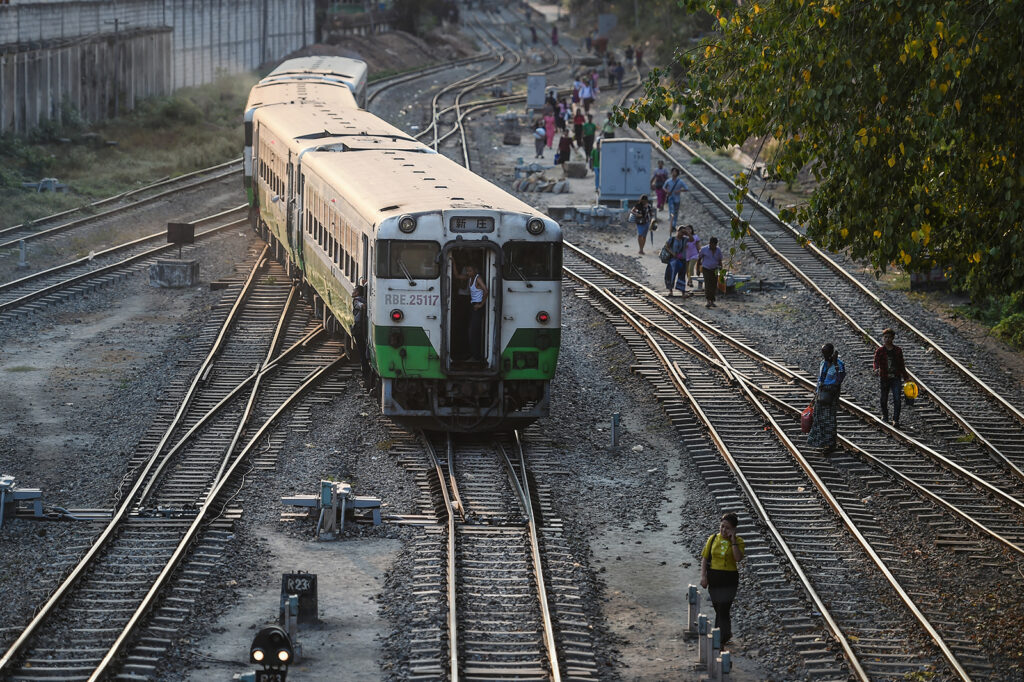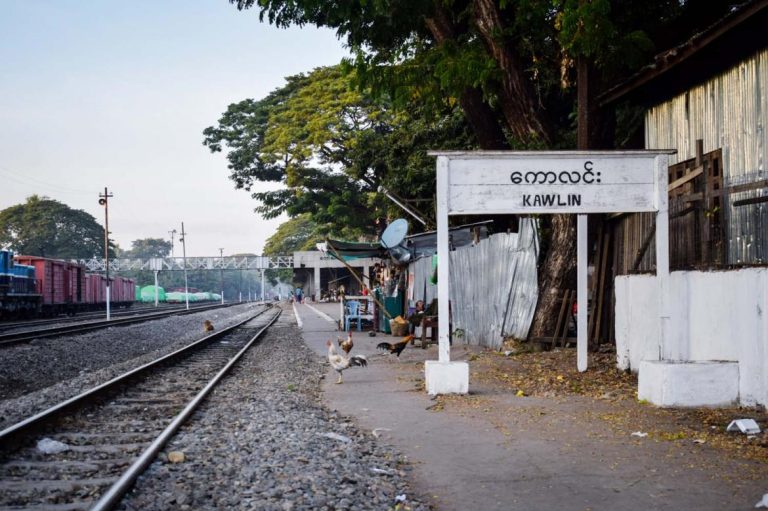The resistance is increasingly targeting the railway network as the regime revamps it to transport troops and supplies, while civilian passengers risk getting caught in the crossfire.
By FRONTIER
As a railway bridge over a small creek explodes in a shower of debris, a group of resistance fighters can’t contain their jubilation. “It’s collapsed – totally collapsed! This is so cool!” shouts one of the fighters.
The scene on July 26 in Sagaing Region’s Wetlet Township, recorded in a video seen by Frontier, points to the growing importance of railroads in the war between the junta and pro-democracy resistance forces.
Ko Yazar*, a resistance fighter who took part in the successful sabotage operation, told Frontier that the bridge was on the line linking Mandalay, Myanmar’s second city, with the Kachin State capital Myitkyina.
Rail transport was largely interrupted throughout the country in 2020, during the COVID-19 pandemic, and after the coup over 30,000 government railway staff left their jobs to join the Civil Disobedience Movement against military rule. But the regime began to resume regular services in November 2021.
The Mandalay-Myitkyina line, however, remained disused and overgrown with bushes until soldiers and police officers began to clear it in June.
“The military forces keep moving from Ywar Haung station [in Sagaing town] to repair the railway tracks,” said Ko Yazar, asking that the name of his group be withheld for security reasons. “They’ve already finished repairing the railroad in Sagaing Township and now are moving north to Wetlet Township.”
To deter any disruption to this work, the military has launched brutal raids on villages along the railway tracks in both townships, he said.
“Since the last week of July, the army has burnt to ashes several villages next to the railway. All the villagers fled from their homes. No one dares to go near the tracks that they repaired because they set up forces along the railroad,” Ko Yazar said.
But these raids haven’t stopped resistance forces from launching attacks, because they view the line as critical for the military’s logistics. After the attack on the bridge in Wetlet, other resistance groups known as People’s Defence Forces blew up two bridges in Sagaing’s Indaw Township on July 31 and August 8.
“We’re pretty sure they don’t intend to provide a service to the public, but only to transport their weapons and troops,” said Ko Yazar. “But we won’t let that happen – it would be too dangerous for both residents and our revolutionary forces.”
The junta takes the train
For now, the military is mainly using roads and rivers to transport troops and supplies between Sagaing and Kachin, where the Kachin Independence Army is active.
“The fighting between the military and KIA is intense, and we noticed the military is carrying many weapons by using the rivers,” said Ko Thapyay*, leader of the Unicorn Defence Force in Sagaing District. “I heard nine military boats arrived at the Bhamo port [in Kachin] in the third week of August.”
But these shipments are far from secure. “Their ships cannot travel through our areas safely because many PDFs in villages along the banks of the Ayeyarwady fire missiles at them,” Ko Thapyay told Frontier.
“In the hot season [from March to May], the river is quite shallow and narrow. It’s difficult to carry heavy items, and the revolutionary forces will not miss a shot if they attack the boats. I think that’s why they’re trying to reopen the train service,” he said.
The Mandalay-Myitkyina line connects with the route from Mandalay to Yangon in lower Myanmar. Besides civilian passengers, it has previously been used to convey timber, gemstones and minerals extracted in Kachin and elsewhere in upper Myanmar all the way to Yangon, from where goods are shipped across the world. From Mandalay, freight can also be sent via a separate train line going north-east across Shan State to Lashio, near the Chinese border.
Because investment and tax receipts have plummeted since the coup, the junta has become more reliant on extractive industries. This makes the rail network important to the regime’s economic survival.
“There’s lots of mining operations in Kachin, including many owned by Chinese citizens,” said Ko Soe Win Swe, a political activist and co-founder of the Sagaing Forum, an initiative that brought together various resistance groups in the region earlier this year. “The railroad was used in the past to carry the minerals to Mandalay. To use it now, the military will need heavily armed troops, but I think they will do it because the profits will offset the costs.”
He told Frontier these troops “would definitely launch attacks on the villages along the tracks. It’s very dangerous for the people living along the railway.”
Elsewhere in Myanmar, the military is already using the railway network to transport troops and supplies. Accordingly, the resistance is increasing its attacks on the railroads.

On August 18, a freight train from Mandalay to Yangon was destroyed by an improvised explosive device in Bago Region’s Kyauktada Township. No group has taken responsibility for the attack.
Ma Chu Chu*, a resident from a village near the railroad where the blast took place, told Frontier that services were suspended for two days to repair the track.
“I’m not sure, but we heard that it was a train carrying weapons for the military, and it was attacked by the Karen National Union and PDF joint forces,” Chu Chu said, although Frontier could not verify what the cargo contained.
Meanwhile, the railroad between Yangon and Mawlamyine, capital of Mon State, has been sabotaged at least 10 times, in Kyaikto, Thaton, and Bilin townships, since it reopened last year.
A PDF fighter in Thaton told Frontier on the condition of anonymity that the Yangon-Mawlamyine railroad is the Tatmadaw’s main means of transport in this area of southeastern Myanmar, justifying resistance attacks.
“If they go on the highways, they are often victims of mines, so they switched to trains to bring military equipment, weapons and ammunition into our state. So, we have to blow up the railway track and trains,” he said.
Meanwhile, the railways are allegedly being improved with overseas support. Activist group Justice for Myanmar has claimed that upgrades financed by the Japan International Cooperation Agency have continued since the coup.
JICA did not answer Frontier’s requests for comment, but it told Japanese newspaper Asahi Shimbum on May 31 that Japan has suspended new loans for Myanmar since the military takeover, and that it is also withdrawing its official development assistance for the upgrading of the line connecting Yangon with Mandalay.
But regime-controlled media have repeatedly boasted of this project’s progress. In January, then-Minister of Transport and Communications Admiral Tin Aung San visited project sites in Bago Region’s Nyaunglebin Township. Myanma Railways says it will finish the Yangon-Taungoo section by May next year, with 60 percent already completed, and that it will then proceed on to Mandalay with continued Japanese assistance.
Attacks under wraps
The train is the cheapest way to travel in Myanmar. Myanma Railways counted more than 47 million passengers in 2018, the latest available data.
Due to the post-coup conflict, travelling by bus has become increasingly dangerous, but now railway passengers risk being caught in the crossfire.
Resistance groups accuse the military of transporting soldiers and weapons on carriages with civilian passengers, in order to deter resistance attacks. Using human shields in this way is a war crime according to the Rome Statute of the International Criminal Court.
Myanmar is not party to the Rome Statute, meaning the military leadership cannot be charged by the court for crimes committed within the country. The National Unity Government, the parallel authority formed by ousted lawmakers after the coup, applied to join the statute on behalf of Myanmar in July 2021 but the request remains pending.
Potentially, though, resistance forces might also be guilty of war crimes if they attacked those same trains, because the statute also criminalises “intentionally launching an attack in the knowledge that such attack will cause incidental loss of life or injury to civilians”. Moreover, the NUG’s own military code of conduct forbids all attacks on civilians.
Perhaps for this reason, resistance groups often don’t publicise their assaults on the railways. In fact, Unicorn Defence Force leader Ko Thapyay said the People’s Administration Team for Sagaing Township, a civilian body under the NUG, requested his group to keep silent about their attacks.
Some supporters of the resistance are unhappy about these operations. U Nay Linn*, a railway station master in Sagaing’s Shwebo Township who left his post to join the Civil Disobedience Movement, said the railroads belonged to the public and “destroying the tracks and the trains isn’t the answer. The groups destroying the train system must be held accountable once the civilian government is restored.”
He admitted that some attacks to disrupt military operations might be justified, but said resistance forces need to take extra care beforehand. “If the resistance wants to fight against the military, they should investigate where the military uses the railroad, and they should attack them only when they are sure of that,” he told Frontier.
But Ko Thapyay believes such voices are in the minority, and that most members of the public are willing to accept the risk to civilian life and inconvenience if attacks impede the military. For this reason, he thinks the enforced secrecy is misguided.
“We depend on the people’s support to get funding, and the more we make our operations public, the more funding we receive. We want to make all of our missions public, but we are working under the Sagaing PAT, and they prohibited us from talking about the attacks on the railway. In fact, we don’t care that much about international law because the military is using the rail tracks for military purposes,” he said.
The Sagaing Township PAT did not respond to Frontier’s request for comment.
Ko Htet Aung*, a member of Monywa Battalion 7, a resistance force in the township of the same name in Sagaing, said his group would destroy the tracks and trains if the junta uses them for military purposes – and that civilian passengers must travel at their own risk.
“Trains haven’t resumed in Monywa yet, but all the railroad tracks here are ready to be used,” he told Frontier. “If the junta starts using trains for military missions, we won’t hesitate to destroy them. So, I want to warn the public not to use the trains if they open the line, because we’re ready to stop the military from using the railway by any means.”
* indicates the use of a pseudonym for security reasons







